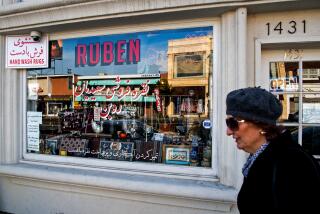Captives to the romance of the subcontinent
- Share via
No encounter between colonizer and colonized ever spun so tight a skein of cultural resentments and affections as that between the British and Indians. The relationship was founded on a paradox. It was premised on differences of culture, race and religion -- differences believed to be so absolute that in the eyes of the British complete segregation was demanded. Yet what sustained it was a continual discovery and (coy) acknowledgment of commonalities and sometimes complicit interests. The British were at pains to keep themselves distant and to assert their superiority precisely because they felt so strongly the magnetic tow of India and its ways. But to their consternation they found themselves dealing with a civilization in many respects more advanced and refined than their own.
Alongside this feeling of cultural vulnerability was a sense of physical threat. Coming from a small and faraway island, the British in India lived in enclaves dotted across a vast and dizzying land. They had to rely on the support of Indians to help sustain their rule, and this forced them into proximity with those whom they ruled. Hence a fear on the part of the British, well-charted in Linda Colley’s “Captives,” that it was they who were vulnerable to becoming “captive”: not just literally, but metaphorically too. A recurring colonial nightmare was to see one of their own “going native,” becoming a social and cultural renegade. And indeed, boundaries were crossed often.
The intermingling of British and Indian worlds has become easier to see in part as a result of a sea change in our understanding of precolonial, particularly 18th century, India. The conventional picture was one of stagnation and decay, in which the British confronted and easily pushed over the hollowed walls of the Mughal empire. But recent historical work by scholars such as Chris Bayly and Sanjay Subrahmanyam shows a different India: commercially advanced and vigorous, culturally open, militarily skilled and possessing sophisticated systems of information gathering and distribution. This was not an insulated civilization overripe for colonial picking and conquest, but rather one that outside powers had to acquaint themselves with and accommodate themselves to in order to win it over from the inside. Far from stampeding across India, the British were compelled to extend their dominion gradually, slowly converting -- over a period of a century or more -- their mercantile trading rights into political sovereignty. It was a process in which Indians were fully complicit, if often only in their own duping and dispossession.
Drawn willy-nilly into the courtly world of the Mughal rulers and their regional satraps, the British had to learn the languages, partake of the rituals -- such as khilat, the exchange of robes between Indian prince and British merchant, which established a relationship of authority and subordination -- and engage, often happily enough, in wholesale cultural cross-dressing.
William Dalrymple’s new book, “White Mughals,” is devoted to a particularly colorful example of just how intimate the encounter between British and Indian could get, and how barbed the consequences could be: the story of James Achilles Kirkpatrick and a young and beautiful woman of Persian descent, Khair un-Nissa, who, amidst intrigue and conspiracy, became his bride.
The story is set in the Deccan stronghold of Hyderabad, capital of a vast swath of southern India. Hyderabad was, by the end of the 18th century, a major commercial junction and “the unrivalled centre of the hybrid Indo-Muslim civilization of the Deccan.” Against expectation, it was inland cities like Hyderabad, Benares, Lucknow and Delhi that were India’s most sophisticated and cosmopolitan. Their sensual and blended air connected British and Indian in ways unknown in the colonial port cities of Calcutta, Bombay and Madras, where racial distinctions remained sharp and where a cordon sanitaire was maintained between the British and the “black town.”
Kirkpatrick arrived in Hyderabad in 1794 and, in 1797, was appointed the East India Company’s resident, or ambassador, at the Nizam of Hyderabad’s court -- a position he held till his death in 1805. He knew Indian languages and Persian and cultivated a genuine taste for things Indian -- including women. Already, before his great romance with Khair, we learn in passing that he had acquired an Indian concubine, by whom he had a son. Kirkpatrick adapted to local ways, adopted “Mussulmen’s dress” and dyed his hair and hands with henna. (He had also, Dalrymple informs us, taken on the “Eastern habit of belching appreciatively after meals.”) He built himself a fine residency in the Palladian style, whose grounds were, according to one contemporary observer, “laid out partly in the taste of Islington & partly in that of Hindostan.”
He first met Khair, a great-niece of the Nizam’s prime minister, in 1798, when she was a girl of barely 13 or 14. An affair was struck up. Yet for all of Khair’s centrality to Dalrymple’s story, we actually have little sense of her heart. Dalrymple has labored hard to unearth private papers and correspondence, which provide rich detail about Kirkpatrick and his world; but as Dalrymple himself notes, in the absence of any of Khair’s own letters, “we can see her only obliquely, reflected through the eyes of her lover, her husband, her mother and her children. Only rarely -- and then indirectly -- are her own words recorded.” Indeed, she flits and slips through the pages of the book, a spectral figure without real volition.
Her insubstantiality somewhat blunts Dalrymple’s effort to portray this as a great love story. Kirkpatrick believed she had fallen in love with him, but we can only surmise Khair’s own feelings. As Dalrymple writes, the supply of young girls as wives or concubines to rulers and powerful men “had long been a means of preferment in courtly India.” Love marriages were rare in Muslim courtly society; most likely it was her mother and grandmother who pushed Khair into Kirkpatrick’s bed, hoping such an alliance would benefit their family.
The affair was sealed by marriage in 1800: Kirkpatrick had to convert to Islam and apparently underwent circumcision. As a result, he was made to suffer by a colonial establishment increasingly under the sway of Evangelical views. Arthur Wellesley -- the future Duke of Wellington and the East India Company officer in charge of the Deccan -- represented this new chill wind and is the villain in Dalrymple’s story. Breaking with British practice, he took to bullying Indian rulers, instructed Kirkpatrick to renege on agreements made with the Hyderabad court, and then worked to trap Kirkpatrick himself -- since he viewed the marriage to Khair as “an outrage upon the general principles of normality.” Faced with Wellesley’s harassment, Kirkpatrick withdrew from political activity and devoted himself to building pleasure gardens and palaces.
Dalrymple provides plenty of opportunity to feel sorry for Kirkpatrick. But in fact it is the story of Khair un-Nissa that reads like that of a lamb to slaughter. She bore Kirkpatrick two children; at 5 and 3 they were torn from her and shipped to England, never to be seen by her again. That same year -- 1805 -- Kirkpatrick died while visiting Calcutta. The grieving Khair was then befriended by Kirkpatrick’s private secretary, Henry Russell, a preening and self-serving fortune hunter. He preyed on her grief, seducing and then betraying her. She died at 28, an outcaste from her own family, abandoned by her British friends and relatives, heartbroken, living her last years exiled in a squalid town. It’s not clear that this is the best advertisement for the British-Indian encounter.
Dalrymple, a renowned travel writer, has labored intrepidly in the archives, and there is much to admire in this book, which exudes his affection for India and a fascination with human character. But the narrative shape of “White Mughals” too often collapses in the face of his determination to display all that he has learned. Dalrymple has achieved in this inordinately digressive book a quality I had previously thought unique to the Bollywood film: the ability to be at once breathless and long-winded.
In fact, one might read this as an example of a hitherto unknown genre: Bollywood History, with stagey diversions, set pieces and a surfeit of costume melodrama. Dalrymple’s itinerant prose too is a problem, and one feels at times lost in the pages of “Tintin Goes to India”: “In the streets crowds of Persians and Arabs in flowing robes joined turbaned Mughals from Delhi and Lucknow, Portuguese horse-traders from Goa and parties of Dutch jewellers up from their base on the coast at Masulipatam. Together they explored the bazaars, testing the delicacies of the city’s famous confectioners or lingering before the fragrant stalls of the perfumers.” And so on.
More troublingly, that the young Khair un-Nissa might have been no more than a honey trap rather takes the blush off what Dalrymple claims is his purpose in this book -- to show the willing intermixture, assimilation and hybridity of the two civilizations, British and Indian. At the end, we are left with the question of what exactly to make of these “White Mughals”: Should we, as Dalrymple would have us, celebrate them as multicultural frontiersmen, prototypes of Rushdiean East-West intermingling? Or are they better seen as opportunist adventurers, grasping their pleasure and fortune wherever they could, taking full advantage of the moral license afforded by being miles away from their British homes?
More to Read
Sign up for Essential California
The most important California stories and recommendations in your inbox every morning.
You may occasionally receive promotional content from the Los Angeles Times.













